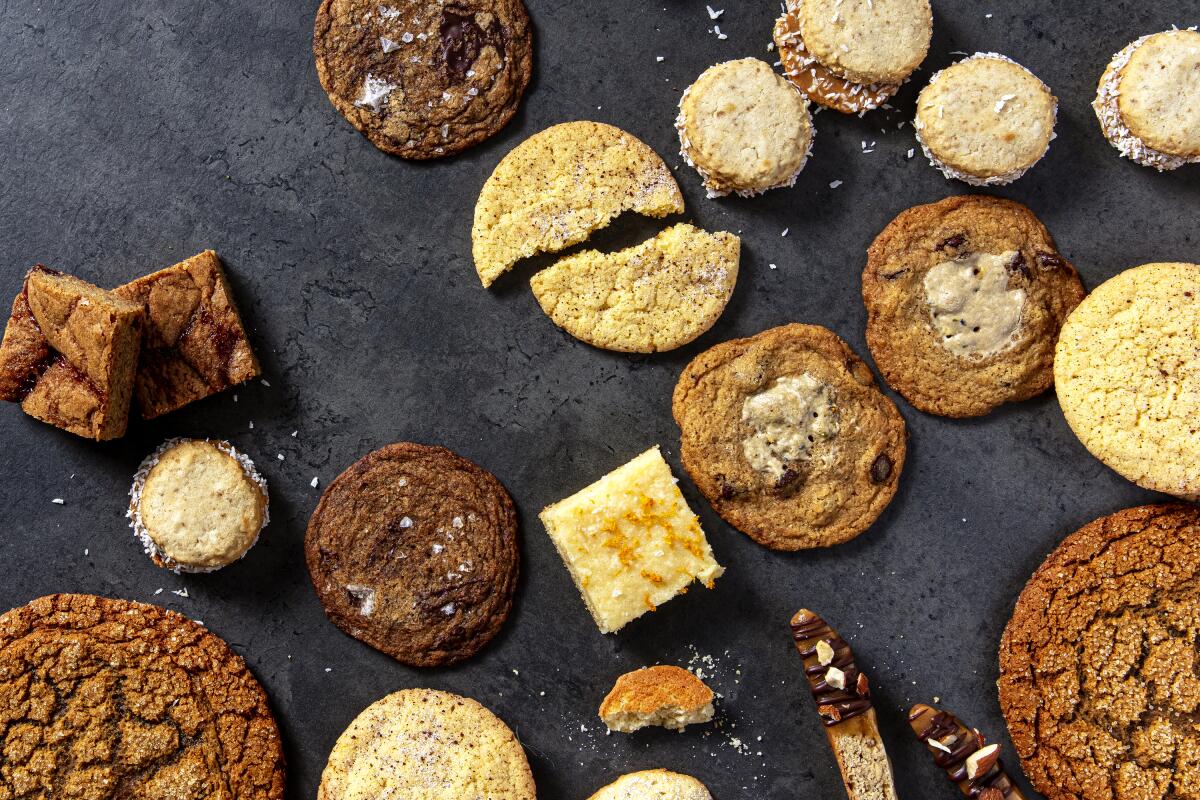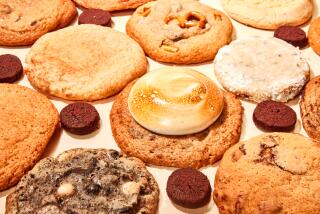How to make the best cookies for the holidays

For this year’s holiday cookie package, we asked nine pastry chefs to share their favorites. All of these cookies are simple and homey but are nonetheless precise and meticulously crafted. To ensure yours come out perfectly, follow these tips:
Room temperature ingredients: This perennial plea is probably the most important. When creaming butter and sugar to make cookie dough, you’re doing more than simply getting the two ingredients to a similar, smooth consistency. You’re also creating an emulsion so that all the ingredients stay together when baked, giving you a homogenous dough for your cookie. If you use cold butter, it takes longer and will be more difficult to combine with the sugar. Likewise, if you use cold eggs, it can seize the butter when you add them, causing the mixture to appear split and lose its emulsion.
If you plan ahead, the easiest way to get room temperature butter and eggs is simply to leave them out overnight on your counter the day before you plan to bake (I promise, it’s safe). But if you didn’t plan ahead, here are the methods I use to quickly get “room temperature” butter and eggs.
For butter, place the stick, still closed in its wrapper, in the microwave and heat in 5-second bursts until it’s just soft to the touch; this usually takes no more than two or three bursts for one stick.
For eggs, place the eggs, still in their shells, in a bowl and cover them with hot tap water. Let sit for 1 minute, then pour off the water and cover the eggs again with fresh hot water. Let sit for at least 5 minutes — or while you prep the rest of your ingredients — until they lose their chill and are room temperature throughout.
Use cookie scoops: While it may seem that scooping dough from your dinner spoon is easy, it comes with a host of issues, from uneven cookie sizes to messy fingers. Do like the pros and buy a set of cookie scoops (my favorite are from OXO). They keep your hands clean, but most important, ensure even, consistent sizing of dough balls so all your cookies bake at the same speed and give you the proper yield.
And while you’re using them, make sure to level the scoop — and all measuring spoons — off flat. For measuring spoons, this ensures you don’t use too much of an ingredient, causing your cookies to malfunction from too much baking powder or soda. Likewise for cookie scoops, you get the proper yield of dough for your cookies — the difference between leveling off scoops and not can add up to 5 to 8 lost cookies in the final yield.
Use bread flour where indicated: It may seem counterintuitive to use bread flour for cookies, but some cookies — like the Giant Ginger Molasses Cookies and Alfajor de Nuez — need that extra protein and gluten to keep the cookie from falling apart or bending. You can use all-purpose flour, if you must, but know that the results will be less crisp and/or snappy without bread flour.
Chill your dough: You may notice that a lot of cookie recipes call to let the dough rest overnight in the refrigerator. This does a couple things: One, it allows the flour to fully hydrate in the dough, resulting in better textures, especially in cookies where a chewy texture is desired. And two, the temperature of the dough is just as important as that of the oven. If you bake a chilled ball of dough, it will spread more slowly and bake up with a crisp edge and soft middle, qualities desired in certain cookies. Whereas, if you bake room temperature dough, the cookies may spread too fast and overcook.
Similarly, the order of chilling and scooping the dough matters too. Some doughs you will want to scoop, then chill because they would be too firm to scoop in their chilled state. On the other hand, some doughs need to be chilled first because they’re too soft to handle at room temperature. Pay attention to the order so you’re not faced with either a cement block of dough that even the best scoop can’t break through or a mess that sticks to your hands and collapses into a blob on the sheet.
Take care with placement of cookies on baking sheets: Some cookies spread more than others. So while it may seem like you can fit 15 dough balls on a baking sheet, once they bake, you’ll be met with a single cookie the size of your baking sheet. Pay attention to the number of dough balls per sheet in the recipes, whether it’s three or 15, and make sure to give them equal space between so they bake evenly and don’t end up touching.
Consider salt differences: Some recipes call for kosher salt, while others call for fine sea salt or table salt. It may seem like salt is salt, but each weighs differently, and its volume measure can’t be swapped one-to-one. Since we at the L.A. Times test kitchen use Diamond Crystal kosher salt as our default (like the majority of the cookie contributors), we give that measurement for the cookies. We give it as an alternative in the few recipes that call for a different salt.
How you measure matters: Some ingredients, like the espresso powder in the Browned Butter Espresso Cookies, calls for a rather odd “4 tablespoons” measurement. If you’re an experienced cook or baker, you know that’s equal to 1/4 cup, so, why not use that instead? Please don’t. Powdered ingredients like espresso powder, dry milk powder and cornstarch measure differently between these two methods, so always stick with the measurement stated in the recipe to ensure you get an accurate yield.
More to Read
Eat your way across L.A.
Get our weekly Tasting Notes newsletter for reviews, news and more.
You may occasionally receive promotional content from the Los Angeles Times.











